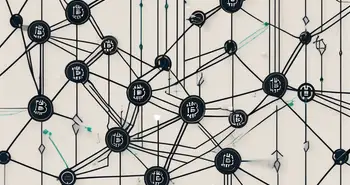SegWit and Bitcoin: The Ultimate Guide to Transaction Efficiency

In 2017, Bitcoin users faced significant delays and high fees due to block size limitations. SegWit was introduced to mitigate these issues and improve the overall efficiency of the network.
SegWit, short for Segregated Witness, is a protocol upgrade for the Bitcoin network that addresses long-standing issues such as transaction malleability and block size limitations. By restructuring how data is stored in blocks, SegWit enables more efficient transaction processing, leading to several improvements in the network's functionality and performance.
In simpler terms, SegWit separates the digital signature (witness data) from the transaction data, reducing the overall size of the transaction. This allows more transactions to be included in each block, enhancing the throughput of the Bitcoin network.
The Purpose of SegWit
The primary purpose of SegWit is to increase the efficiency and scalability of the Bitcoin network. By separating the transaction signatures from the transaction data, SegWit reduces the size of each transaction, allowing more transactions to be included in each block. This not only helps in handling more transactions per second but also in reducing transaction fees due to better utilization of block space.
Moreover, SegWit also aims to fix transaction malleability, a bug that allowed attackers to manipulate transaction IDs, causing potential confusion and delay in transactions. By addressing this issue, SegWit enhances the security and reliability of the Bitcoin network.
Since its activation, SegWit has enabled the Bitcoin network to handle a higher volume of transactions with lower fees. For example, in 2020, the average transaction fee dropped significantly as more transactions adopted SegWit.
How Does SegWit Work?
SegWit achieves its goals by storing transaction signatures (witness data) outside the main block structure. This enables faster validation and reduces the vulnerability to transaction malleability—a process that could alter transaction IDs, potentially causing confusion or delays.
By moving the witness data outside the traditional block structure, SegWit allows more transactions to fit into a block, leading to faster processing times and reduced fees. This architectural change is crucial for improving the network's scalability and efficiency.
Furthermore, SegWit also paves the way for the implementation of second-layer solutions like the Lightning Network. This off-chain solution enables instant transactions with extremely low fees, making microtransactions feasible on the Bitcoin network.
The Benefits of SegWit
Backward Compatibility
One of the key benefits of SegWit is its backward compatibility. This means that older Bitcoin software can still interact with the upgraded SegWit transactions, ensuring a smooth transition for users and businesses. This feature is particularly important as it allows for a gradual adoption of the upgrade without disrupting the existing ecosystem.
Moreover, backward compatibility ensures that users do not need to immediately upgrade their wallets or software to start benefiting from SegWit. They can continue to use their current systems while gradually transitioning to SegWit-compatible versions.
Enhanced Security
SegWit enhances the security of the Bitcoin network by fixing the transaction malleability bug. This bug allowed attackers to manipulate transaction IDs, potentially leading to double-spending attacks. With SegWit, this vulnerability is significantly reduced, making the network more robust and reliable.
Additionally, by addressing transaction malleability, SegWit improves the reliability of multi-signature transactions, which are essential for various advanced features like payment channels and smart contracts.
The History of SegWit
The Creation of SegWit
SegWit was first proposed by Bitcoin Core developer Pieter Wuille in December 2015. Wuille's proposal aimed to address the scalability issues faced by the Bitcoin network, particularly the block size limit, by separating the transaction signature data from the transaction data.
After months of rigorous testing and development, SegWit was finally activated on the Bitcoin network through a soft fork in August 2017. This marked a significant milestone in the evolution of Bitcoin and paved the way for further advancements in blockchain technology.
The activation of SegWit was a contentious process within the Bitcoin community, with significant debate and discussion about its potential impact. However, the eventual activation demonstrated a successful example of consensus and collaboration within the decentralized network.
Adoption and Implementation of SegWit
Following its activation, major companies and wallets gradually adopted SegWit. Companies like Coinbase, Bitfinex, and Bitstamp integrated SegWit support into their platforms, encouraging users to take advantage of the improved scalability and reduced fees offered by the upgrade.
By early 2021, over 70% of Bitcoin transactions were using SegWit, demonstrating its successful integration into the ecosystem and leading to a more efficient Bitcoin network.
The adoption process involved significant coordination and updates across the Bitcoin ecosystem. Wallet providers, exchanges, and payment processors needed to update their systems to support SegWit transactions, which in turn, encouraged more users to adopt SegWit.
The Benefits of SegWit
Increased Transaction Speed
With SegWit, the Bitcoin network can process a higher number of transactions per second. This means less waiting time and quicker confirmations for users. Increased transaction speed is crucial for the usability of Bitcoin as a currency, particularly for everyday transactions and payments.
Improved Scalability
One of the critical challenges faced by the Bitcoin network was its limited block size. SegWit addresses this issue by optimizing the use of block space. By reducing the size of transaction data, SegWit allows more transactions to fit into a block, boosting the network's overall scalability.
The adoption of SegWit laid the groundwork for the Lightning Network, which allows for near-instantaneous transactions off-chain, significantly improving Bitcoin's scalability and enabling microtransactions.
With improved scalability, the Bitcoin network can support more users and a higher volume of transactions without experiencing congestion and high fees. This scalability is essential for the long-term growth and adoption of Bitcoin.
Enhanced Security
SegWit provides a layer of security by fixing the issue of transaction malleability. With the separation of witness data from transaction data, the potential for altering transaction IDs is greatly minimized. This enhanced security measure ensures that transactions are less prone to manipulation, making Bitcoin more reliable and trustworthy..
The improved security features of SegWit have also boosted confidence among institutional investors and businesses, contributing to the wider acceptance and integration of Bitcoin in various industries.
Criticisms and Controversies Surrounding SegWit
Opposition to SegWit
Some members of the Bitcoin community were opposed to the activation of SegWit due to concerns about centralization. Critics argued that the upgrade could lead to a concentration of power among a few key players, potentially undermining the decentralized nature of Bitcoin. However, the activation of SegWit proved successful, and its widespread adoption has garnered support from many industry participants.
Despite initial resistance, many critics of SegWit, such as the Bitcoin Unlimited group, eventually acknowledged its benefits post-implementation and saw the positive impact on the network's scalability and efficiency.
Potential Drawbacks of SegWit
Like any other protocol upgrade, SegWit has its potential drawbacks. One such concern is the backward compatibility with older wallets and software services. While most new services now provide support for this protocol upgrade, some older wallets and exchanges are yet to implement SegWit. This delay in adoption can cause fragmentation within the network and inconvenience for users.
Another potential drawback of SegWit is its complexity, which can make it challenging for developers to implement and maintain. Ensuring that SegWit is properly integrated into existing systems and that all transactions are correctly formatted requires a high level of technical expertise. Despite these challenges, the benefits of SegWit in terms of scalability and transaction malleability fixes have made it a crucial upgrade for the long-term health of the Bitcoin network.
SegWit and Bitcoin
The Impact of SegWit on Bitcoin
SegWit has had a transformative impact on the Bitcoin network. It has helped address major issues, improving transaction speed and scalability. Furthermore, SegWit has paved the way for the implementation of second-layer scaling solutions like the Lightning Network, which promises even faster and cheaper transactions on the Bitcoin network.
The integration of SegWit and the subsequent development of the Lightning Network have enabled Bitcoin to handle millions of transactions per second off-chain, significantly enhancing its use case as a global payment system.
SegWit's Role in Bitcoin's Future
As Bitcoin continues to evolve, SegWit will remain an integral part of its future. The widespread adoption of SegWit has set the stage for further innovations in blockchain technology and improved user experiences.
With SegWit unlocking the potential to solve crucial scalability issues, it positions Bitcoin for wider adoption and creates a solid foundation for future developments. Innovations like Schnorr signatures and Taproot are expected to build on SegWit's improvements, further enhancing the efficiency and privacy of the Bitcoin network.
FAQ – Frequently Asked Questions
What is the primary purpose of SegWit?
The primary purpose of SegWit is to increase the efficiency and scalability of the Bitcoin network by reducing transaction sizes and solving transaction malleability issues.
How does SegWit improve transaction speed?
SegWit increases transaction speed by enabling more transactions to fit into a single block. By separating the witness data from the transaction data, SegWit reduces the size of each transaction, allowing for faster processing times.
Is SegWit widely adopted?
Yes, SegWit has gained significant adoption since its activation. Many major wallets, exchanges, and businesses now support SegWit, improving transaction throughput and reducing fees for Bitcoin users.
Does SegWit enhance the security of Bitcoin transactions?
Absolutely! SegWit enhances the security of Bitcoin transactions by fixing the issue of transaction malleability. The separation of witness data from transaction data minimizes the potential manipulation of transaction IDs, making transactions more secure and reliable.
What role does SegWit play in Bitcoin's future?
SegWit plays a crucial role in Bitcoin's future by addressing scalability issues and providing a solid foundation for further innovations. With SegWit in place, Bitcoin is poised for wider adoption and continuous development in the blockchain space.
I hope you found this ultimate guide to SegWit informative and helpful. The implementation of SegWit has been an exciting milestone for the Bitcoin network, bringing about tangible improvements in transaction speed, scalability, and security.
As an expert in blockchain technology, I encourage you to embrace SegWit and explore the multitude of opportunities it unlocks for the future of Bitcoin and the wider cryptocurrency ecosystem.
Remember, staying up-to-date with the latest technological advancements is key to staying ahead in the ever-evolving world of cryptocurrencies.
Happy SegWit-ing!
As you embrace the advancements brought by SegWit and look to the future of Bitcoin, consider taking your trading experience to the next level with Morpher. Morpher's revolutionary platform leverages the power of blockchain to offer zero fees, infinite liquidity, and a unique trading experience across a variety of asset classes. With the ability to trade fractional shares, engage in short selling without interest fees, and enjoy up to 10x leverage, Morpher is designed to democratize trading for investors around the world. Sign up now to take control of your investments with the Morpher Wallet and get your free sign-up bonus. Sign Up and Get Your Free Sign Up Bonus to start trading the future with Morpher.

Disclaimer: All investments involve risk, and the past performance of a security, industry, sector, market, financial product, trading strategy, or individual’s trading does not guarantee future results or returns. Investors are fully responsible for any investment decisions they make. Such decisions should be based solely on an evaluation of their financial circumstances, investment objectives, risk tolerance, and liquidity needs. This post does not constitute investment advice.

Painless trading for everyone
Hundreds of markets all in one place - Apple, Bitcoin, Gold, Watches, NFTs, Sneakers and so much more.

Painless trading for everyone
Hundreds of markets all in one place - Apple, Bitcoin, Gold, Watches, NFTs, Sneakers and so much more.









